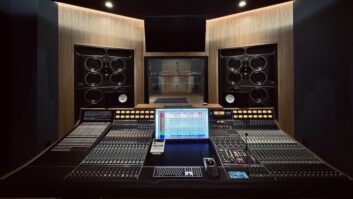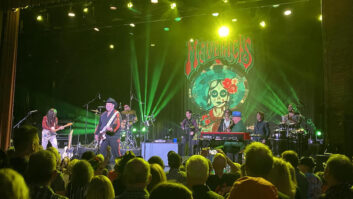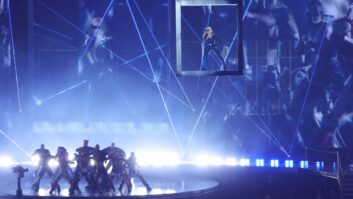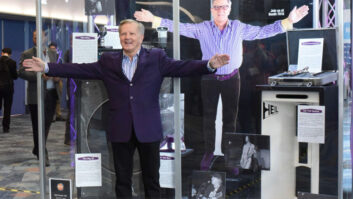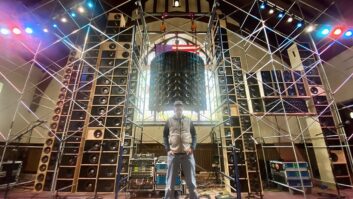The massive L-Acoustics K1/K2 system fielded by Delicate Productions for the current Foo Fighters tour gets tuned daily with tracks ranging from Alison Krauss to Massive Attack’s “Angel.” The advent of digital recording has forever changed the music industry, and it’s certainly affected the live sound experience, too. Most touring FOH engineers are now tasked with preserving every show for eternity on hard drives, and the front rows of any concert have become a forest of outstretched arms capturing video on smart phones. And with the growing number of digital console systems offering Virtual Soundchecklike capabilities, one would expect that those features would supplant the long-standing tradition of engineers checking the PA by listening to familiar favorites—the cliché example being Steely Dan and Donald Fagan tracks. Perhaps surprisingly, however, using pre-recorded music to listen for anomalies remains the way to go. We asked engineers on a variety of tours about what they’re listening to when they’re tuning the PA, and the answers were surprisingly broad.

George Thorogood and the Destroyers play through the PA of the day, so production manager/FOH engineer Jeff Pitt has plenty of experience getting a system in shape for a night of growling vocals and guitars to match. “For source tuning material, I utilize a couple of tracks from Jonny Lang’s Lie To Me record,” he said, “because it has incredible space, and the mix style is very similar to that of my own. It’s a thick but punchy bottom end; the guitars and vocal tend to pop out and will show the ugly tonality of a PA in the 2.5 k range, as well as the low-mid thickness in the 250-400 range. The other predominate piece I’ll use is the classic Dire Straits track, ‘Money For Nothing.’ It just has all of the pieces I need and is very musical. I do use Virtual Soundcheck to qualify my source tuning if time permits.”
Sometimes tuning a PA can change your life; that’s what happened to Phil Reynolds, system engineer for Foo Fighters: “I was doing an install at church about 14 years ago, and we played Massive Attack’s ‘Angel.’ It was the first time we fired up the rig—the bass hit and I said ‘I’m quitting college. This is what I need to do.’ I have a couple of tracks that I use—‘Angel,’ Tower of Power’s ‘Diggin’ on James Brown,’ Alison Krauss and a Tabla drum track that’s really good for attack and tonality of time between front fills and mains. Then if I’m feeling it and want to hear what’s going to come out of the desk, I’ll do a little bit of virtual soundcheck—kick, snare, hat, bass, guitar—to see if everything’s locking together.”
Florida/Georgia Line’s system engineer, Philip Kriz, tends to turn to Green Day tracks like “Know Your Enemy,” noting, “The drums, the guitars and the vocal are really big in those songs, and we want those out above it all. I use those songs to get what I need out of the PA and then I use another song to walk the room and do time alignment. If there’s a song with a connection to a town, I’ll use that—like when we were in Moline, IL the other day, I used ‘John Deere Green’ by Joe Diffy. So we use one or two tracks that are the same every day and then I try to switch it up, to not drive everybody insane.”
Mads Mikkelsen, who tackles FOH mixing for Danish metal act Volbeat, shared, “I use music that I know exactly how it should sound if I tune the PA right, and then I use some songs that have extreme low-bass drops to test sub levels; this is also a very good way to test festival generators—if they can’t keep up, you will see a power drop, and in the worst case, you will hear the digital equipment lose frames. I’ve made cut-up, looped versions of the tracks I use to tune, so the parts I need to hear are looped and the track doesn’t end when I walk the field or venue floor. The tracks are Rammstein’s ‘Mein Herz brennt’—good kick and nice transparent sound; Nevermore’s ‘The River Dragon Has Come’—good guitars and a very tight kick sound, but in a different frequency than Rammstein; and the very loud bass drop from Fear Factory’s ‘What Will Become.’”
Eric Roderick, FOH engineer with The Zac Brown Band, told PSN last year, “I used to use a lot of Amos Lee just because of pitch of his voice. If there’s a really active room, his voice will excite those trouble areas—the 2 k or maybe a little 800. That was stuff I look for in ringing out PAs.”
Not everyone turns to tracks, however. When FOH engineer Gordon Reddy was on tour with Fun., he wryly offered, “My favorite song is Pink Noise. I gave up on this whole thing of trying to impress the artist with the really obscure, bizarre track that I could pick to walk around the venue and listen to. Pink Noise is as short as I want, as long as I want, all the energy is everywhere, and once you get used to what that sounds like coming out of the PA, you know what it needs.”
Eddie Mapp, out on the road right now with Papa Roach, also eschews tunes: “No music for me—I prefer to use Smaart 7 for all of my system tuning and alignment. Aside from first verifying that each part of the system is working together properly or at least in time together, I then tune the system to the frequency response that I prefer and know my mix will translate as I intend it to.”
Still, there are plenty of engineers out there who continue to use Steely Dan albums and Donald Fagen’s solo debut, The Nightfly, as go-to recordings for tuning a PA. So if everyone uses Steely Dan, what does a Steely Dan tour use?
Mark Dowdle, the band’s FOH engineer, told us last year with a chuckle, “I’ve been tuning PAs all over the world with Steely Dan songs for almost 40 years, but I chose not to do that on this gig—you know, just didn’t seem like the thing to do! I use a couple of things: Thomas Dolby’s Aliens Ate My Buick—there’s a cut on there called ‘My Brain is Like a Sieve’—and then I also use a cut off Frank Zappa’s Joe’s Garage, ‘Lucille.’ That has a great, very natural sounding vocal, and that helps me get the PA close to where I want it. But primarily I use a microphone and talk through the PA. Every record’s mixed differently, every cut is going to have a different frequency response, none of them are going to be the same, and to think that they’re going to give you exactly what you need in a specific room? It’s not going to happen—but a microphone’s consistent, it’s going to be the same every time you talk into it, and as far as I’m concerned, it’s the best way to voice a PA.”
Briefs
Sennheiser MobileConnects
ORLANDO, FL—Sennheiser (Sennheiser.com) debuted its MobileConnect streaming solution—a new technology intended to provide capabilities and features to the hearing and visually impaired—in the US at a performance of Cirque du Soleil’s La Nouba during InfoComm. Sennheiser worked with Cirque de Soleil’s production crew and FOH sound technicians to create and send two separate channels—one capturing all of the stage microphones, the other capturing the stage microphones plus the production intercom—to MobileConnect apps on visitors’ personal devices.
The Grateful Dead Splits
GAINESVILLE, FL—For the Grateful Dead’s final shows—the Fare Thee Well mini tour—longtime sound provider Pro Media/UltraSound turned to Gainesville, FL-based Ramtech (ramtech.net) to design and construct a specialized splitter for the minitour’s stage input and output system requirements. The result was a four-way transformer isolated splitter with two direct RamLatch outputs—one with ground-lift switches and two RamLatch transformer-isolated outputs—using Jensen JT-MB-D isolation transformers, also with ground-lift switches. For more on the mini-tour.
Ambisonic Augments El Portal
NORTH HOLLYWOOD, CA—The El Portal Theatre in N. Hollywood, California recently renovated its audio system, opting for an STX loudspeaker system from Ambisonic Sound Technologies (ambisonicST.com). The system design includes one array on either side of the stage, each consisting of an STX6620 and STX4625 line array loudspeaker. The system uses an additional STX4625 array cabinet to cover the front audience area, and a DRM212 woofer cabinet was flown with each array to increase low frequency output and overall system dynamics.
